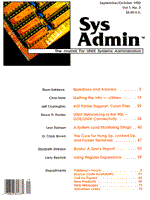
Sidebar: Paging and Swapping Under SCO UNIX
The SCO UNIX operating system has two types of memory management: paging and swapping. Greg Oetting at SCO Support explains the differences: Paging occurs when the system is low on memory, and is done on a page-by-page basis. When the amount of free memory reaches the value of the kernel parameter GPGSLO, the system goes through all of the pages in memory to see if any of them are old. Old pages will then be either thrown away -- as in the case of program text -- or written to the swap area -- as in the case of data pages. Paging continues until the amount of memory reaches the value of the kernel parameter GPGSHI, at which point processing resumes. Swapping occurs when there is no memory left -- when, for example, a process requests 300Kb of memory when only 150Kb remain. In this case, the system goes through and swaps out to disk any data regions and throws away text regions. The main difference between paging and swapping is that swapping is on a larger scale.
|